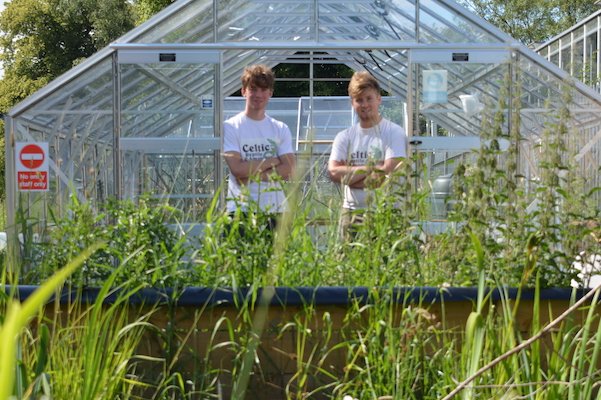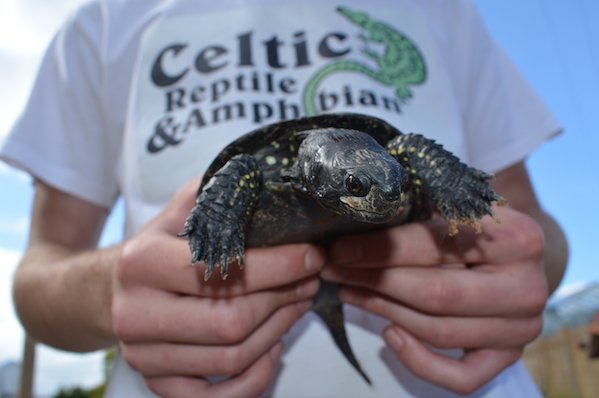“The great thing about a passion is that if you truly believe in it and you feel it’s what you were born to do, you will find time for it,” says Harvey Tweats, an 18-year-old rewilder.
He’s referring to a rather ambitious and time-consuming project that he has embarked on with friend-turned-colleague Tom Whitehurst, also 18, alongside their school studies for the past two years.
The pair used their weekends and evenings — and some all-nighters — to research and build a reptile facility near where they live in Staffordshire in order to breed endangered amphibians, snakes, turtles, and lizards native to Britain and Europe with a view to reintroduce them to the wild.
After initially promoting their project on Facebook, they founded the organisation Celtic Reptile & Amphibian, and have since received funding and support from environmentalists running similar initiatives including Dominic Buscall from the Wild Ken Hill rewilding project in Norfolk, and Charlie Burrell from the Knepp Rewilding project in West Sussex. They’ve also already made the national news.
Tweats told Global Citizen he was inspired to attempt the feat after a trip to a rewilded farm in Coombeshead, Devon, where renowned expert Derek Gow had successfully reintroduced beavers, which are extinct in the UK, and is breeding wild pigs, wild cats, and storks on his land too.

Tweats and Whitehurst love animals like snakes and frogs, but say these creatures have often been left out of reintroduction or conservation efforts, partly because “people are scared of them”, Tweats says, laughing. The duo have now finished their A-levels, and are enjoying having the extra time to dedicate their summer to looking after their amphibians at the facility.
They are part of a burgeoning trend of young environmentalists who see rewilding – defined as the large-scale restoration of nature – as one of the best solutions to both the climate and ecological crisis.
Leading voices on the subject include Greta Thunberg and Sir David Attenborough, who both advocate for the idea because of its benefits for sustainability, not least because all sorts of wild places like woodland, peatlands, seagrass meadows, mangrove forests, and more will store carbon dioxide if left to their own devices, taking the greenhouse gas out of the atmosphere and therefore helping to reduce global warming.
But the harsh reality right now is that the wilderness is being lost. Young people like Tweats and Whitehurst and fellow rewilders believe it ought to be restored for the benefit of future generations.
“We are in a crisis which every single day gets worse, species become threatened with extinction every year,” Tweats explains. “Only 3% of ecosystems are intact globally and in Britain ancient woodlands are being lost, 97% of meadows have gone, and practically all rivers are unhealthy. We’re in a serious mess.”
In this context, Tweats continues, rewilding is the “only way out of the mess”, because it’s about getting back to what has already been lost on a huge scale.
He explains that rewilding is slightly different to conservation in that regard, which is the perhaps better known concept of conserving what is still there in a habitat.
To learn more about the difference between the two ideas, Global Citizen spoke to Richard Bunting, an expert and spokesperson for the charity Rewilding Britain — the UK’s biggest rewilding charity which focuses on getting landowners to rewild their estates. He says rewilding “is kind of like nature conservation on steroids, because of the scale of it.”

“Conservation is often focused on preserving or saving a specific habitat or species, and often requires intensive management to do so,” Bunting continues. “But rewilding is more about a bigger scale, and while it involves some intervention at points, it is also sometimes about taking your hand off the steering wheel. Letting nature take over.”
There are different aspects to rewilding, but reintroducing species that have reached low numbers and which require truly wild, restored habitats to survive, is part of it – and that’s what Tweats and Whitehurst are aiming for with the animals they are breeding.
“We are looking for an ideal habitat [for our animals], one that has been restored back to nature, that can’t just be a field with no insects to eat or other amphibians to interact with,” Whitehurst explains. “It has to be a wild area. It’s trial and error, but we would like to prove that it’s possible to reintroduce them in the UK,” he adds.
The benefits if they are successful will be huge, he says, because the whole food chain will benefit. “They’ll attract foxes and birds who eat them. For example, we’ve seen with other attempts to do this in parts of Europe that it helps boost the numbers of other species in the area because ultimately there’s just more food to eat,” Whitehurst explains.
Tweats adds: “Not only are they a vital food base, but frogs and lizards also eat pests and mosquitoes that would otherwise eat crops or give humans diseases."
“Snakes eat rats and mice that carry ticks on their fur that can sometimes carry Lyme’s disease, so they can actually help reduce the likelihood of Lyme’s disease.”
The biggest benefit of this project and the others like it, the pair emphasise, is the overall environmental impact. “Climate change and nature are interlinked,” Tweats says. “You don’t have a healthy climate without healthy nature.”
How you can get started in rewilding
You might not find it so straightforward to actually start breeding animals like Tweats and Whitehurst have done — although their YouTube channel does provide a lot of information and care guides for their different creatures.
However they’ve done a lot of research and sought expert advice to do what they do safely. They have strict protocols to monitor any diseases in the animals and stop them from spreading.
If you’re a beginner at rewilding, there are easier steps you can take to get started, says Bunting from Rewilding Britain. If you have a garden, you could simply let parts of it run wild, or perhaps even dig a pond.
“All the gardens in the country add up to a huge area,” says Bunting. “So there’s a huge amount that can be done just in the UK’s gardens.”

He explains that bees are having a difficult time surviving because there is just too much distance between the nectar from flowers, their food source. “It’s about connectivity. The more people who allow wild flowers to grow in their garden, the more wildlife corridors there would be around the country for bees,” he says. “A big issue in Britain is how fragmented and disconnected to each other wild areas are.”
A clear of symbol of that disconnection are barriers like fencing — Bunting recommends cutting a small gap in your fence if you have a back garden, so that hedgehogs can walk between gardens, as they need a large territory to roam. Hedgehogs are vulnerable and their numbers are declining — partly because they don’t have enough space to move around.
He also recommends writing to your local council and encouraging them not to keep the grass verges around roads and pathways so neat. “They hear a lot from constituents who want things to be neat all the time, and see lawns mowed. So it would be great if they heard more from people who want to see them do more to boost biodiversity by not doing that,” he explains.
This might mean looking at messiness a little differently. For example, as Bunting says: “dandelions are considered a weed, and they are actually a wildflower that supports lots of pollinator species, but they are often mown down.”
Finally there are lots of rewilding organisations you can support too in different ways.
As well as Rewilding Britain, Scotland Big Picture, a non-profit which raises awareness of the benefits of rewilding, has a Next Gen programme which seeks young volunteers to get involved with projects and advocate for nature restoration. There is also Heal, a group which fundraises to buy land and rewild it, and the Rewilding Europe Network, which connects groups involved in rewilding across the continent.
Another way to get involved would be to visit rewilded estates and see it for yourself, like the Coombeshead farm in Devon, or one of the biggest, Knepp Wildland in West Sussex.
Tweats and Whitehurst also recommend letting your garden go wild if you have one, and digging a pond of course, for the benefit of amphibious animals. Mostly though they just want everyone to advocate for a wilder land as part of an overall effort to fight climate change.
“We need a technology push to reduce emissions — but we also need a technology reduction in some areas,” says Tweats. “We need to step back from large areas of land, and let it regenerate.”
“That’s what this project is about for us. It’s not just about getting to see some beautiful lizards, it’s vital to humans and the planet,” he adds.
You can join the Global Citizen Live campaign to defeat poverty and defend the planet by taking action here, and become part of a movement powered by citizens around the world who are taking action together with governments, corporations, and philanthropists to make change.
